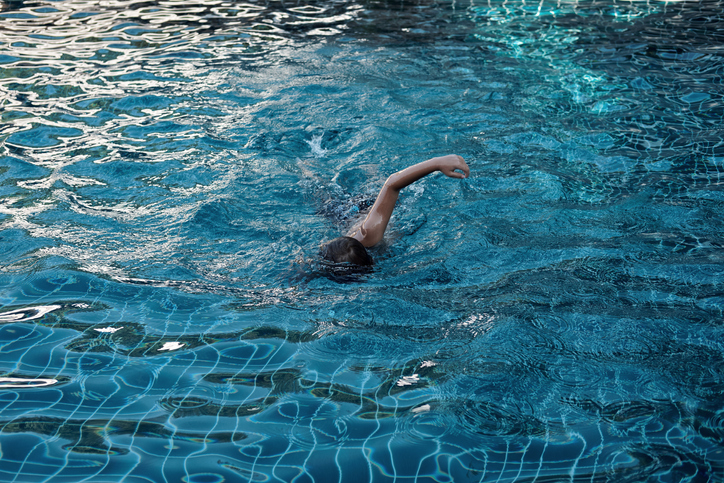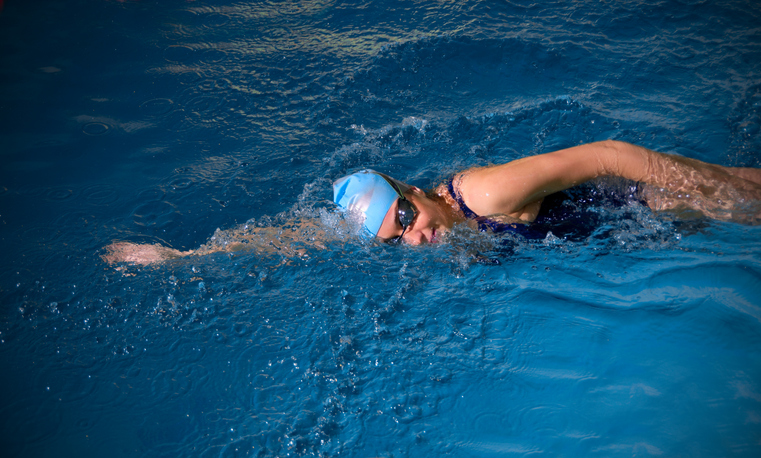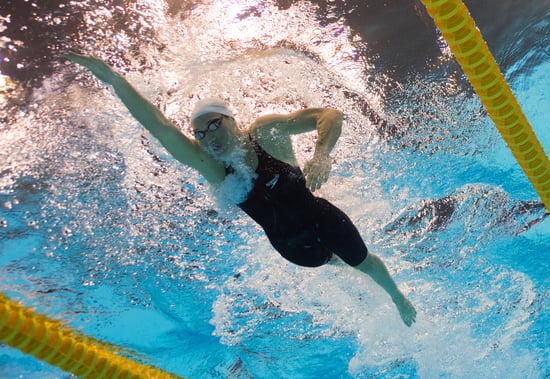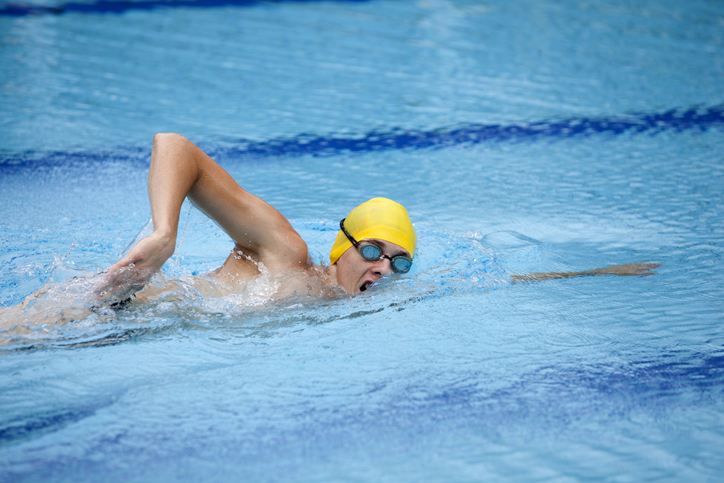Introduction to Freestyle
Freestyle comes down to proper technique. You get there with drills and exercises. It starts with your dive, stroke technique, flip turn and ends with your finish. You emerge from the surface of the water with a uniform streamline, proper buoyancy, head facing the bottom, fingers together, feet kicking and ready to begin your stroke.

Freestyle gets faster and subsequently easier with proper breathing and stroke technique. I cannot stress enough how important it is to always imagine the word “Stroke” as both upper and lower body motions. It really is your entire body that must participate. You must have a balanced stroke, continuing to move your legs and your upper body at all times.
Notice, I did not say emerge and begin breathing. Instead I said begin your stroke (freestyle.) Depending on your level of expertise, do your best to take 1-2 strokes before taking your first breath. This is an excellent habit to get into for your stroke rate. The longer you can go without taking a breath off your dive, without compromising your front crawl stroke technique, the better.
The following 5 Freestyle Swimming Drills will help you with everything I just mentioned.
Breathing, Balance, Efficiency, Arm Placement & Strength.
Drill #1: “3-5-7 Switch”
It’s important to keep your head down and in line with your torso. As I mentioned, your breathing is also very important. The less you need to compensate for breathing, the faster you’ll be.
This freestyle drill helps you focus on breathing less. You will start each 25m or 50m with a breath every third stroke. You can repeat this as many times as you’d like. When you’re ready, try the same exercise taking a breath every 5 strokes. Then when you feel comfortable with that, you will breathe every 7 strokes. The odd numbers ensures that you’re taking breaths from both sides.

Your head should always be looking toward the bottom of the pool. You may be asking, “Coach, how am I going to see the wall? I need to plan for my flip-turn!” You’re right. Eventually, once you get close enough, you can look up for a second and complete your flip turn or your finish if you need to. This can be avoided altogether depending on your level of skill. You can use the lines at the bottom of the pool to locate your position. You also have the lane and the flags to help you gauge your distance from the wall. Do not look forward. The more you look forward, the more you have a tendency to lift your head which causes your hips and legs to drop which causes drag. Drag will make you work much harder to keep your legs up, causing you to kick harder to compensate which in turn creates more drag and slows you down.
Drill #2: “Balance”
Proper buoyancy is important. This basically means balance between your lower and upper body in the water using the air in your lungs. It helps so that you don’t need to kick as hard to keep your hips up.
Start this freestyle drill technique by applying a downward pressure on your head and upper body. As your lungs are filled with air, they are going to bring your chest to the surface of the water. With the downward pressure you have on your upper body, it creates the perfect balance from the buoyancy in your chest to keep you level and straight on the surface of the water.
Focus on keeping your body level and straight. You want to always be exhaling when you’re underwater, timing your breathing so by the time you plan to inhale, you’re out of air. Sometimes you’ll be taking 3 strokes before inhaling, other times maybe 10 strokes. Practice your breathing and timing so you don’t inhale too soon or too late. These breathing techniques help with getting more oxygen to your brain and muscles. The more you roll from side to side, and use your pull through to glide, the better.
Drill #3 “Gliding”
For this freestyle drill, you’re going to focus on Arm Extension. When your arm is fully extended, you’re going to over rotate a bit and extend as far as you can, glide for 3-5 seconds. Count your glide to perfect your technique. Your other arm is at your side. You will continue to kick normally.

This teaches you how important it is to follow through completely with each stroke. To avoid swimmers shoulder, over time when extending your arm out, avoid completely extending the arm above the water before dropping it and pulling through. Instead, with your palm parallel to the water surface, wrist slightly higher than your finger tips, fingers tightly together, & elbows high, while your arm extends forward, its best to enter the water shortly after your hand is past your head and then extend your arm forward under the water while keeping your palm parallel to the surface. If you don’t pay close attention to the angle of your palm, you could be causing yourself more drag. It’s common for swimmers to get into a bad habit of angling their palms upward slightly at the end of the recovery. I know from experience, it’s nice to imagine that it helps, because it feels right. You want to think you’re exiting the water quicker, when in fact your pushing water forward and causing more drag.
Drill #4 “High Elbows”
This next freestyle drill was already mentioned briefly, and that is High Elbows. This is a pillar in Freestyle stroke technique and there are many exercises that help with this. You will pause at the highest point in which your elbow bends, with the other arm already fully extended, palm facing down, kicking normally. The easiest way to achieve this, is to flex your arm and keep your elbow high in the water when you’re arm is pulling the water so your forearm is facing backward rather than downward for as long as possible, letting yourself glide through the water, taking full advantage of your pull through and recovery. It’s not easy propelling yourself through the water, but this drill helps you focus on your elbow location.
Drill #5 “Single Arm”
This freestyle drill focuses on rotation and builds strength. It’s exactly what it sounds like, using only one arm to stroke while the other is tightly against your side. Breath away from the stroking arm, even if you don’t need to, breath every stroke. It helps with driving proper body rotation. The key to this drill is to ensure that you fully rotate to the dead side. You really have to emphasize driving the dead shoulder into the water as there’s no arm stroke on that side to help you. This drill helps to balance your muscles for your left and right sides.

Freestyle may seem simple, but only if you know the 100 little things to keep in mind while you're doing the stroke. Remembering every little detail during a race is almost impossible. Which is why you practice until it becomes second nature. You could literally do it in your sleep. This is why we have freestyle drills. They help ensure that under any amount of pressure, you’ll be ready to swim and be ready to succeed. I hope you get a chance to try these 5 drills out.
Need some assistance with these swimming skills? Hire a Sunsational swim coach to help perfect your stroke technique and develop a training plan!
Josiah Scrivner's bio:
I’m 25 years old, & I spent 11 years as a competitive swimmer and have 4 years of just coaching. Those were some of the best years of my life. I spent about half of that time teaching others how to swim and passing along any techniques that I learned from the amazing coaches I swam with. I now pass this along to infants and adults alike. Outside of Coaching, I enjoy hiking with my dog and going to the beach to paddle board.
ABOUT SUNSATIONAL SWIM SCHOOL
Sunsational Swim School is the 🥇 #1 rated provider of private, at-home swimming lessons in America. We have specialized swim instructors for students ages 6 months to adult, beginner to advanced. Featured on ABC, CBS, Impact 100, The List and others, Sunsational instructors have a minimum of 2 years of teaching experience, are CPR certified and insured, and have collectively taught over 302,223 lessons for more than 74,415 students nationwide!



